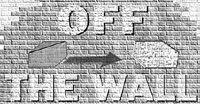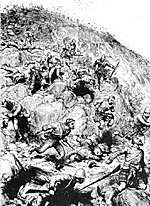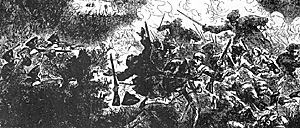 Introduction
Introduction
With the exception of Fire&Fury, or DBA - style games, most morale tables tend to be muoh of a muchness. Start with a basic factor, add variables and a die roll, and then read the result on a table--somewhere between "incontrolled charge" and :flee in disorder."
The following mechanism is a variation of this, but aimed at skirmish games, where it is my opinion that both the mechanism and the results table should be somewhat different: RegimentaI-style rules do not easily transfer to individuals.
If, having read the ideas you like it then, it should be, possible, to tack it onto any existing set of skirmish rules, a mended where required. The ruIes as they appear below were originally written for 18-19th- C. skirmishes involving smugglers, revenue men, and civilians and should be read bearing this in mind.
RATIONALE
 Whilst functioning as part of a unit the
constraints and influences on a
combatant, are somewhat different to
those that would act upon if left to his own
devices. In the regimental case
the individuals' free will is somewhat
constrained. When outside of a unit the
individual largely has only himself to
account to. However, I say "largely"
because of so called peer group pressure
which means that except when truly out-of
sight of everyone there are few men who can
ignore what people m ay see and thus may
think. So there is also, an attempt to bring this
feature of real life into the rules.
Whilst functioning as part of a unit the
constraints and influences on a
combatant, are somewhat different to
those that would act upon if left to his own
devices. In the regimental case
the individuals' free will is somewhat
constrained. When outside of a unit the
individual largely has only himself to
account to. However, I say "largely"
because of so called peer group pressure
which means that except when truly out-of
sight of everyone there are few men who can
ignore what people m ay see and thus may
think. So there is also, an attempt to bring this
feature of real life into the rules.
Skirmish wise constraints and risks are mostly , self imposed, There are rarely "orders from above" to consider.
In short, most self made calls upon an individual are for him to do something requiring more courage (or stupidity?) than that which he is currently doing or has the, chance of doing. Failure to answer this "call to courage" results in the safer option being chosen.
This failure is simply stated but isn't always as straightforward as it seems. The heart of these rules lies in being able to determine a "safe" and a "dangerous" option in any situation.
Some examples are depicted in the table.
SAFE
- Stay in cover when under fire.
Cower in or make maximum use of cover.
Use a slight wound as a reason to retire having "done your share."
Continue to retreat, go home etc.
Run somewhere that is (apparently) safer.
Stay put.
Help an injured friend to safety. And so on.
"DANGEROUS"
- Leave cover when under fire.
Lean over or out of cover to fire at enemy.
Bind up or ignore a wound and continue to participate in the action.
Rally and prepare to rejoin the action.
Receive a charge
Charge the enemy.
Remain in the action.
FACTORS
- +1per incoming shot (umpire's decision as to where "incoming" starts and ends.)
+3per incoming blunderbuss, volley gun or similar worrying shot.
+1grazed or other similar wound or pseudo wound.
+3light wound. (I've done my bit and paid for it.)
+5heavy wound. (What is the inclination to risk more?)
+3 lost a melee. (Lost in the widest sense.)
-2military under direct orders from a leader present
-3pertinent individuals subject to a religious harangue.
+/-2first peer in a group fails or passes. (i.e. the inclination is to do the same)
+/-1per subsequent peer. (i.e. if 5 men fail a test to charge and stay put it's very likely that you'll join them)
+/-2in cover (the inclination is to stay or retreat. Surely only a fool would go forward?)
+/-1Psychological edge (pirate v civilian for example)
+/-2Friend in sight is hit. (Help him or avoid joining him?
-2 Mounted against foot. (I'm bigger and safer up here)
+3 Foot against mounted. (Look at the size of him!)
If you prefer your tabletop characters, to bob out of cover, and shoot wildly at every, half glimpse of an enemy-- then read no further. This mechanism ensures that survival is paramount.
Sensible people stay safely in cove firing at long range at targets that they can't hit and, in any case didn"t want to antagonise.
THE RULES
(With apologies to overdseas readers who may not be conversant with "bottle" as a colloquialism for nerve).
Each character has a "bottle" (or a morale/nerve rating - if, you insist) of between 0 and 5. Look upon these as:
- 0 A psychopath or religious fanatic.
1 Idealists or those with a cause.,
2 A well trained military type one else to, whom danger is an accepted part of life to a degree.
3 Braver civilians and most other military types.
4 Normal civilians. Wary.
5 Self preservationist.
When a morale check is required determine the "safe" and "dangerous" options.
Add the character's basic bottle to the factors on the table overleaf and roll a 10 sided die. If the roll is higher than the calculated total thecharacter takes the "dangerous", option. If equal or lower then the "safe" option is chosen.
If a group of characters all need to test, then the leader tests first. If there is no formally nominated leader (an officer, mayor,etc.) then start with the "toughest" man present, (Lowest: "bottle" the natural fighter as psychologists would say).
The explanation by the factors has been expanded, beyond, that which is required in a rule sheet but I hope you get the rationale.
As with most morale rules, players quickly learn to roll a die and look at a situation deciding the result. The table will only be used in the early days or when the result is likely to be borderline.
WHEN TO USE "BOTTLE"
It can be argued that a test be taken before any remotely aggressive move, but this bogs a game down. Limit tests to x per side per move (in: situations as nominated by the other side) or only to Characters "where it matters" and let the umpire decide.
Results
Using these morale, rules you should, find that, skirmishes have results closer to historical results. There will be a lot of running around, shouting and shooting. When the dust dies down, there will be very, few people dead, a few lightly wounded and, lots, in the, pub telling tales of bravery and derring-do.
SCENARIO
 There isn't one! If the editor decides that this Would be either welcome or help clarify this mechanism then this will appear in a later "Battlefields".
There isn't one! If the editor decides that this Would be either welcome or help clarify this mechanism then this will appear in a later "Battlefields".
[Get Writing, Derek, you know better than to volunteer, surely! This article has decided me to institute a new feature of which this is the first: "Off the Wall` --where contributors look at gaming in an unusual or novel way; sort of a first-cousin to Wargaming Forum. We're not necessarily looking to start a discussion but give you something to think about - Ed.]
Back to Battlefields Vol. 1 Issue 7 Table of Contents
Back to Battlefields List of Issues
Back to Master Magazine List
© Copyright 1999 by Partizan Press.
This article appears in MagWeb (Magazine Web) on the Internet World Wide Web.
Other military history articles and gaming articles are available at http://www.magweb.com